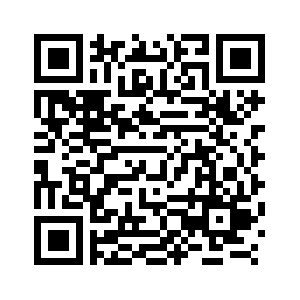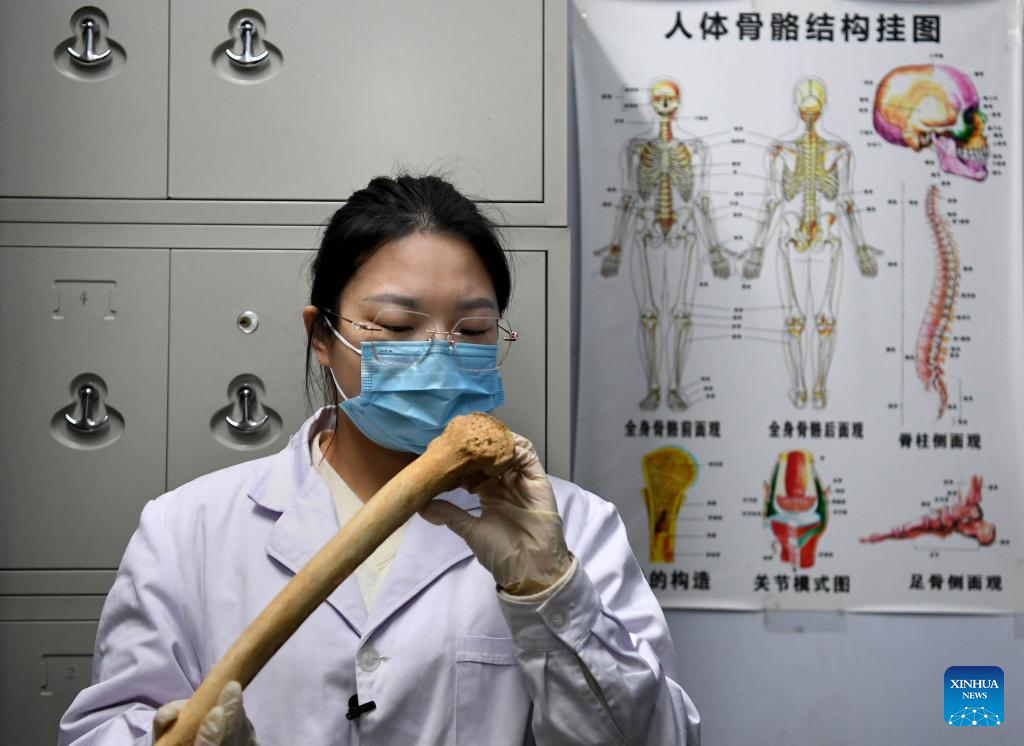
Li Yanzhen observes a human bone at Henan Institute of Cultural Relics and Archaeology in Zhengzhou, central China's Henan Province, Nov. 30, 2022.
At an office full of measuring tools and skeleton specimens at Henan Institute of Cultural Relics and Archaeology, Li Yanzhen, a "post-90s" girl, carefully measures and analyzes an ancient human bone, and speculates on the bone owner's height and nutritional status.
Li, who majored in archaeology, now studies physical anthropology. Li can extract hidden historical information from ancient human remains, such as physical characteristics, growth patterns, diet structure, the living environment, and ancient human customs, through a series of tasks such as cleaning, packaging, measurement, statistics, and analysis.
Li has come into contact with bones from over 30 relic sites from various periods during her four years of research, which lets bones that had been buried for hundreds of years "speak," unveiling the development and change of human society. (Xinhua/Li An)
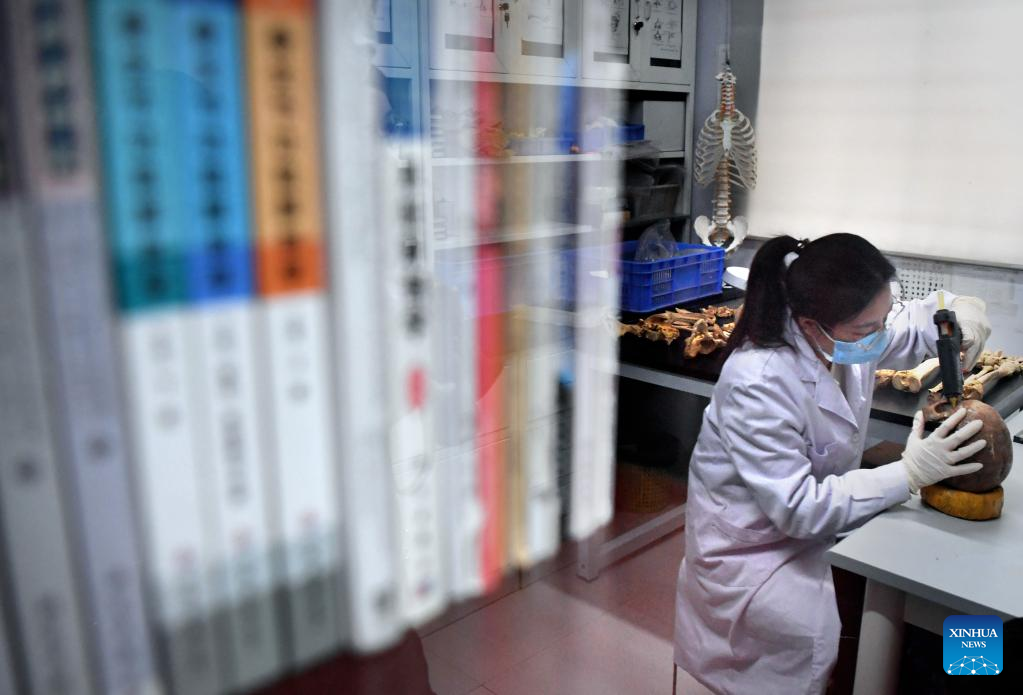
Li Yanzhen repairs a broken skull at Henan Institute of Cultural Relics and Archaeology in Zhengzhou, central China's Henan Province, Nov. 30, 2022.
At an office full of measuring tools and skeleton specimens at Henan Institute of Cultural Relics and Archaeology, Li Yanzhen, a "post-90s" girl, carefully measures and analyzes an ancient human bone, and speculates on the bone owner's height and nutritional status.
Li, who majored in archaeology, now studies physical anthropology. Li can extract hidden historical information from ancient human remains, such as physical characteristics, growth patterns, diet structure, the living environment, and ancient human customs, through a series of tasks such as cleaning, packaging, measurement, statistics, and analysis.
Li has come into contact with bones from over 30 relic sites from various periods during her four years of research, which lets bones that had been buried for hundreds of years "speak," unveiling the development and change of human society. (Xinhua/Li An)
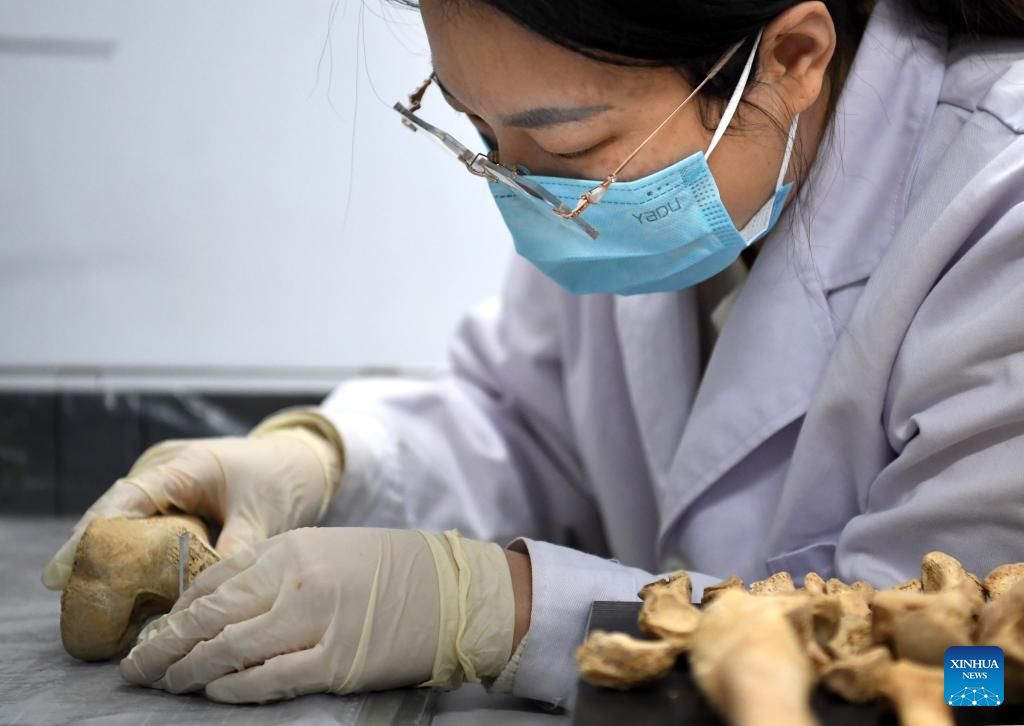
Li Yanzhen observes a human bone at Henan Institute of Cultural Relics and Archaeology in Zhengzhou, central China's Henan Province, Nov. 30, 2022.
At an office full of measuring tools and skeleton specimens at Henan Institute of Cultural Relics and Archaeology, Li Yanzhen, a "post-90s" girl, carefully measures and analyzes an ancient human bone, and speculates on the bone owner's height and nutritional status.
Li, who majored in archaeology, now studies physical anthropology. Li can extract hidden historical information from ancient human remains, such as physical characteristics, growth patterns, diet structure, the living environment, and ancient human customs, through a series of tasks such as cleaning, packaging, measurement, statistics, and analysis.
Li has come into contact with bones from over 30 relic sites from various periods during her four years of research, which lets bones that had been buried for hundreds of years "speak," unveiling the development and change of human society. (Xinhua/Li An)
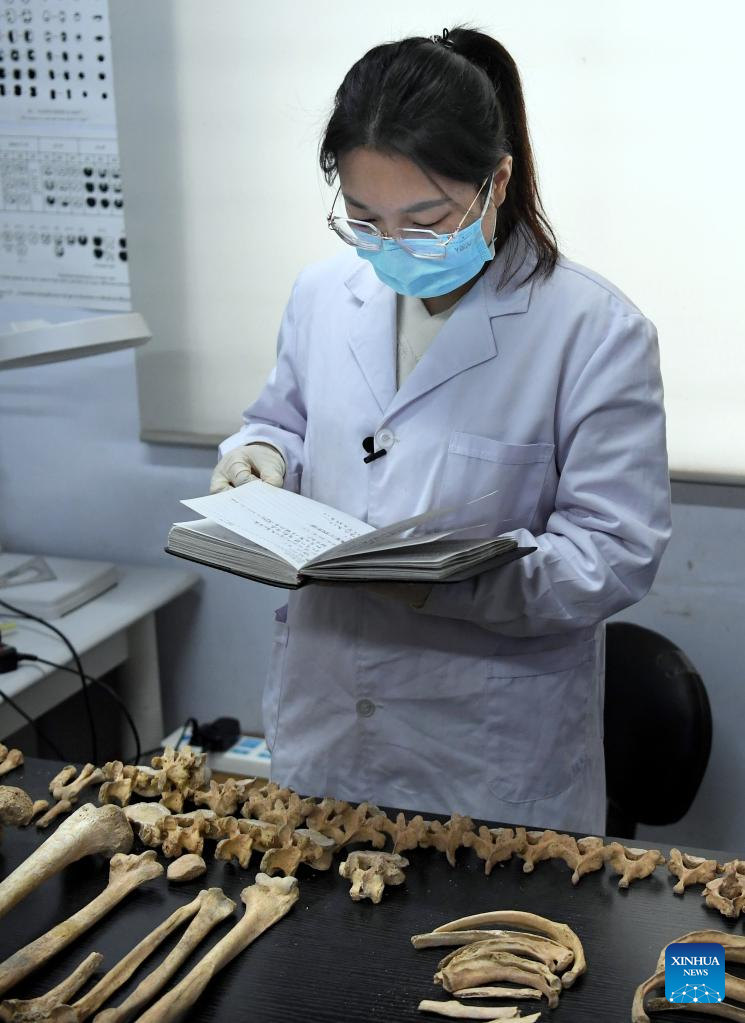
Li Yanzhen reads a note at Henan Institute of Cultural Relics and Archaeology in Zhengzhou, central China's Henan Province, Nov. 30, 2022.
At an office full of measuring tools and skeleton specimens at Henan Institute of Cultural Relics and Archaeology, Li Yanzhen, a "post-90s" girl, carefully measures and analyzes an ancient human bone, and speculates on the bone owner's height and nutritional status.
Li, who majored in archaeology, now studies physical anthropology. Li can extract hidden historical information from ancient human remains, such as physical characteristics, growth patterns, diet structure, the living environment, and ancient human customs, through a series of tasks such as cleaning, packaging, measurement, statistics, and analysis.
Li has come into contact with bones from over 30 relic sites from various periods during her four years of research, which lets bones that had been buried for hundreds of years "speak," unveiling the development and change of human society. (Xinhua/Li An)
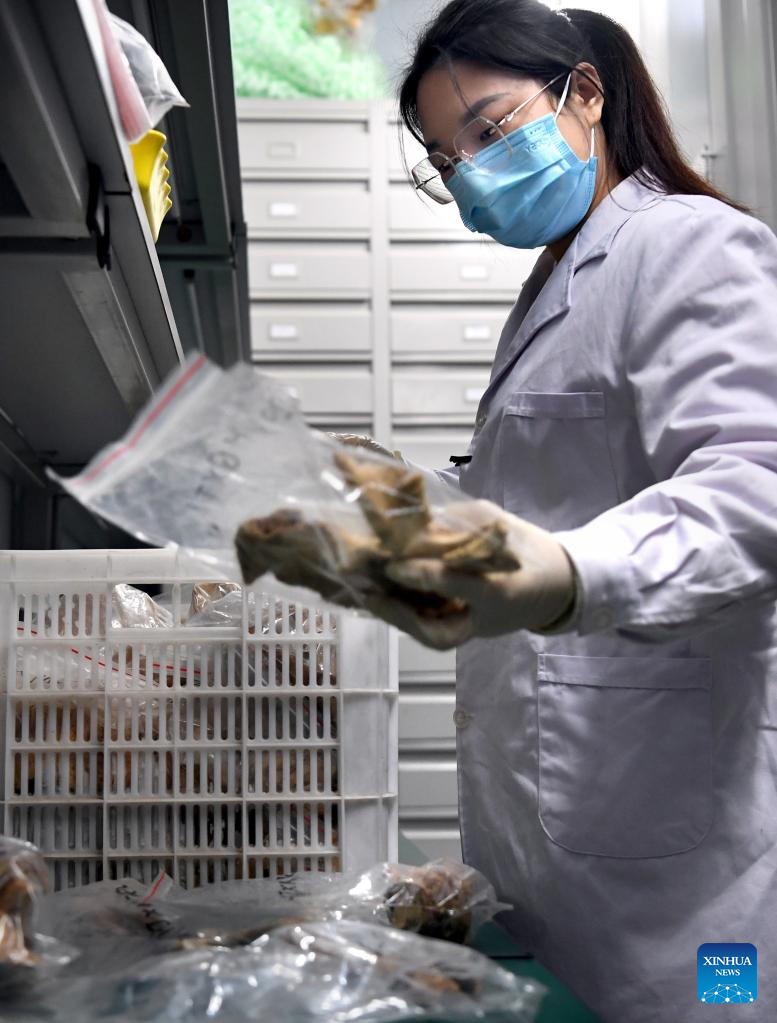
Li Yanzhen organizes human bones at Henan Institute of Cultural Relics and Archaeology in Zhengzhou, central China's Henan Province, Nov. 30, 2022.
At an office full of measuring tools and skeleton specimens at Henan Institute of Cultural Relics and Archaeology, Li Yanzhen, a "post-90s" girl, carefully measures and analyzes an ancient human bone, and speculates on the bone owner's height and nutritional status.
Li, who majored in archaeology, now studies physical anthropology. Li can extract hidden historical information from ancient human remains, such as physical characteristics, growth patterns, diet structure, the living environment, and ancient human customs, through a series of tasks such as cleaning, packaging, measurement, statistics, and analysis.
Li has come into contact with bones from over 30 relic sites from various periods during her four years of research, which lets bones that had been buried for hundreds of years "speak," unveiling the development and change of human society. (Xinhua/Li An)
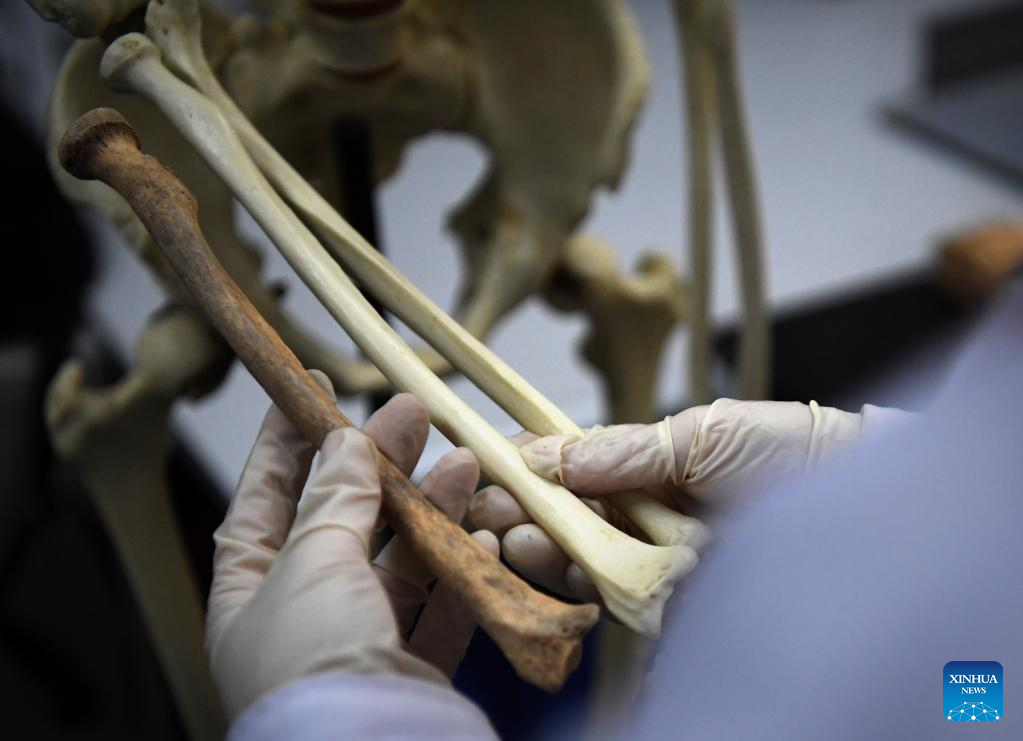
Li Yanzhen compares human bones at Henan Institute of Cultural Relics and Archaeology in Zhengzhou, central China's Henan Province, Nov. 30, 2022.
At an office full of measuring tools and skeleton specimens at Henan Institute of Cultural Relics and Archaeology, Li Yanzhen, a "post-90s" girl, carefully measures and analyzes an ancient human bone, and speculates on the bone owner's height and nutritional status.
Li, who majored in archaeology, now studies physical anthropology. Li can extract hidden historical information from ancient human remains, such as physical characteristics, growth patterns, diet structure, the living environment, and ancient human customs, through a series of tasks such as cleaning, packaging, measurement, statistics, and analysis.
Li has come into contact with bones from over 30 relic sites from various periods during her four years of research, which lets bones that had been buried for hundreds of years "speak," unveiling the development and change of human society. (Xinhua/Li An)
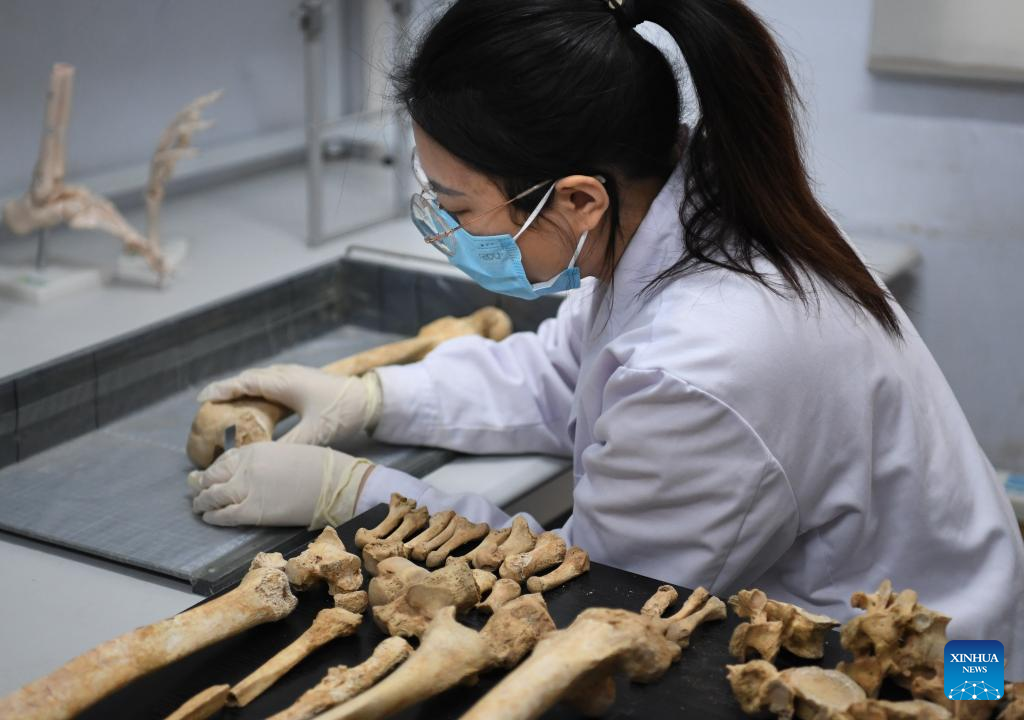
Li Yanzhen measures a human bone at Henan Institute of Cultural Relics and Archaeology in Zhengzhou, central China's Henan Province, Nov. 30, 2022.
At an office full of measuring tools and skeleton specimens at Henan Institute of Cultural Relics and Archaeology, Li Yanzhen, a "post-90s" girl, carefully measures and analyzes an ancient human bone, and speculates on the bone owner's height and nutritional status.
Li, who majored in archaeology, now studies physical anthropology. Li can extract hidden historical information from ancient human remains, such as physical characteristics, growth patterns, diet structure, the living environment, and ancient human customs, through a series of tasks such as cleaning, packaging, measurement, statistics, and analysis.
Li has come into contact with bones from over 30 relic sites from various periods during her four years of research, which lets bones that had been buried for hundreds of years "speak," unveiling the development and change of human society. (Xinhua/Li An)
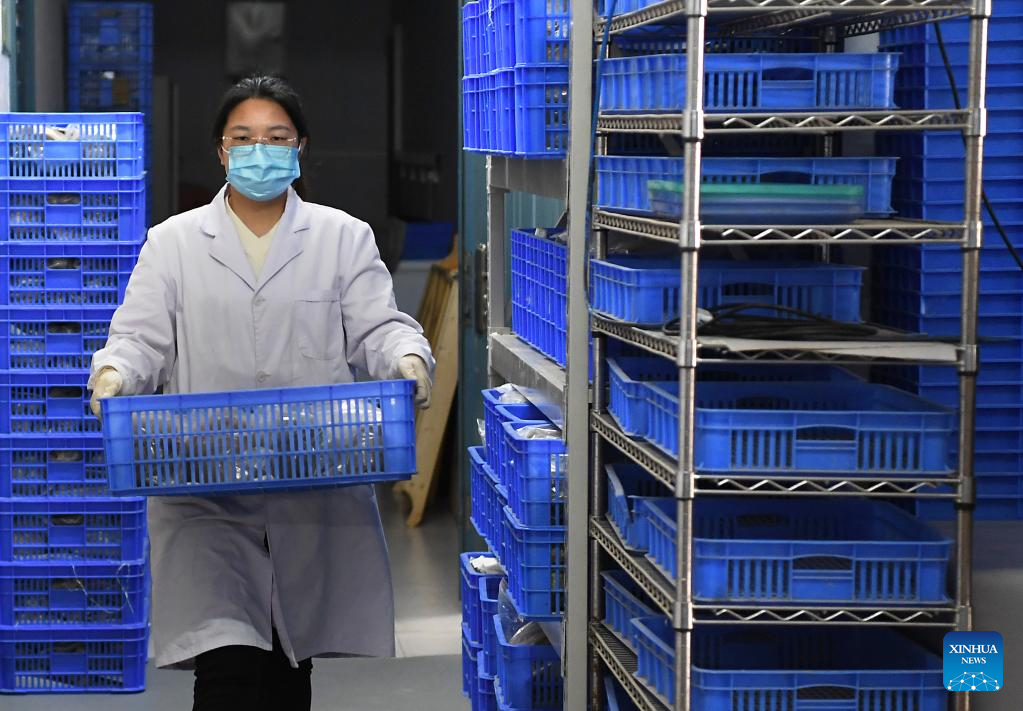
Li Yanzhen carries human bone specimens at Henan Institute of Cultural Relics and Archaeology in Zhengzhou, central China's Henan Province, Nov. 30, 2022.
At an office full of measuring tools and skeleton specimens at Henan Institute of Cultural Relics and Archaeology, Li Yanzhen, a "post-90s" girl, carefully measures and analyzes an ancient human bone, and speculates on the bone owner's height and nutritional status.
Li, who majored in archaeology, now studies physical anthropology. Li can extract hidden historical information from ancient human remains, such as physical characteristics, growth patterns, diet structure, the living environment, and ancient human customs, through a series of tasks such as cleaning, packaging, measurement, statistics, and analysis.
Li has come into contact with bones from over 30 relic sites from various periods during her four years of research, which lets bones that had been buried for hundreds of years "speak," unveiling the development and change of human society. (Xinhua/Li An)
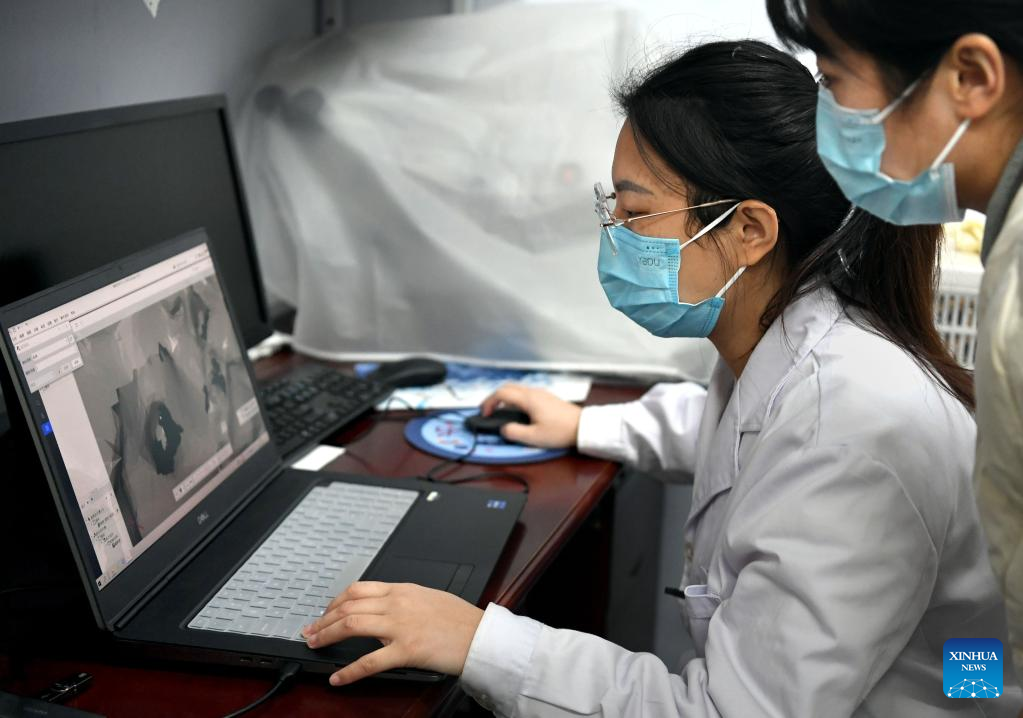
Li Yanzhen details the image of a skull after 3D scanning at Henan Institute of Cultural Relics and Archaeology in Zhengzhou, central China's Henan Province, Nov. 30, 2022.
At an office full of measuring tools and skeleton specimens at Henan Institute of Cultural Relics and Archaeology, Li Yanzhen, a "post-90s" girl, carefully measures and analyzes an ancient human bone, and speculates on the bone owner's height and nutritional status.
Li, who majored in archaeology, now studies physical anthropology. Li can extract hidden historical information from ancient human remains, such as physical characteristics, growth patterns, diet structure, the living environment, and ancient human customs, through a series of tasks such as cleaning, packaging, measurement, statistics, and analysis.
Li has come into contact with bones from over 30 relic sites from various periods during her four years of research, which lets bones that had been buried for hundreds of years "speak," unveiling the development and change of human society. (Xinhua/Li An)
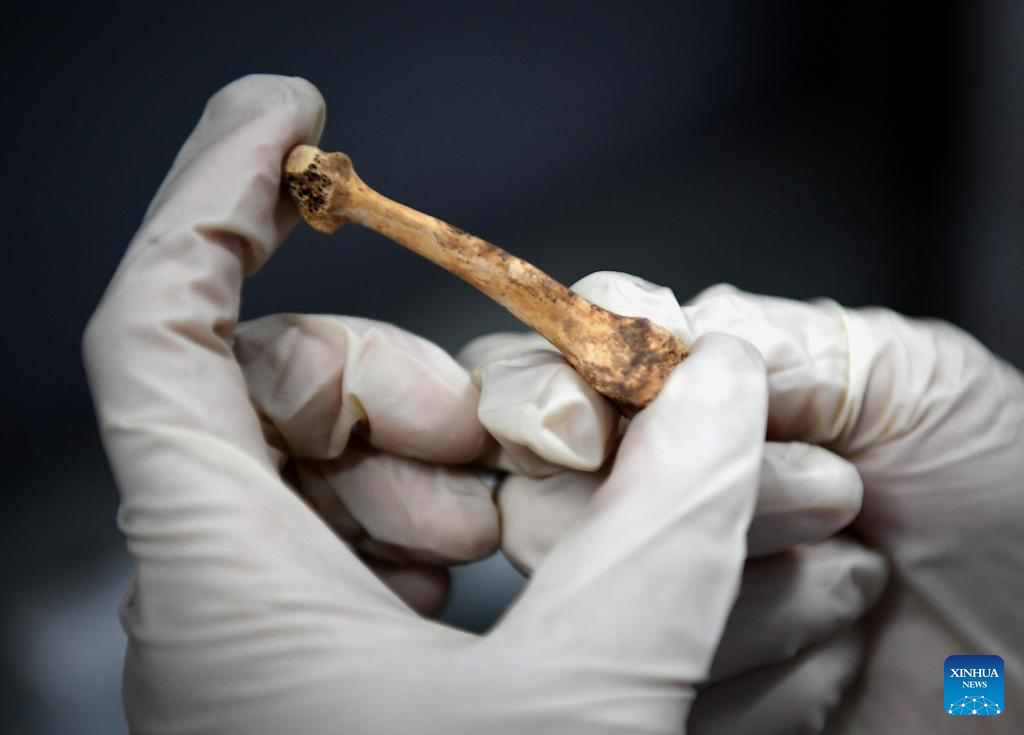
Li Yanzhen observes a human bone at Henan Institute of Cultural Relics and Archaeology in Zhengzhou, central China's Henan Province, Nov. 30, 2022.
At an office full of measuring tools and skeleton specimens at Henan Institute of Cultural Relics and Archaeology, Li Yanzhen, a "post-90s" girl, carefully measures and analyzes an ancient human bone, and speculates on the bone owner's height and nutritional status.
Li, who majored in archaeology, now studies physical anthropology. Li can extract hidden historical information from ancient human remains, such as physical characteristics, growth patterns, diet structure, the living environment, and ancient human customs, through a series of tasks such as cleaning, packaging, measurement, statistics, and analysis.
Li has come into contact with bones from over 30 relic sites from various periods during her four years of research, which lets bones that had been buried for hundreds of years "speak," unveiling the development and change of human society. (Xinhua/Li An)
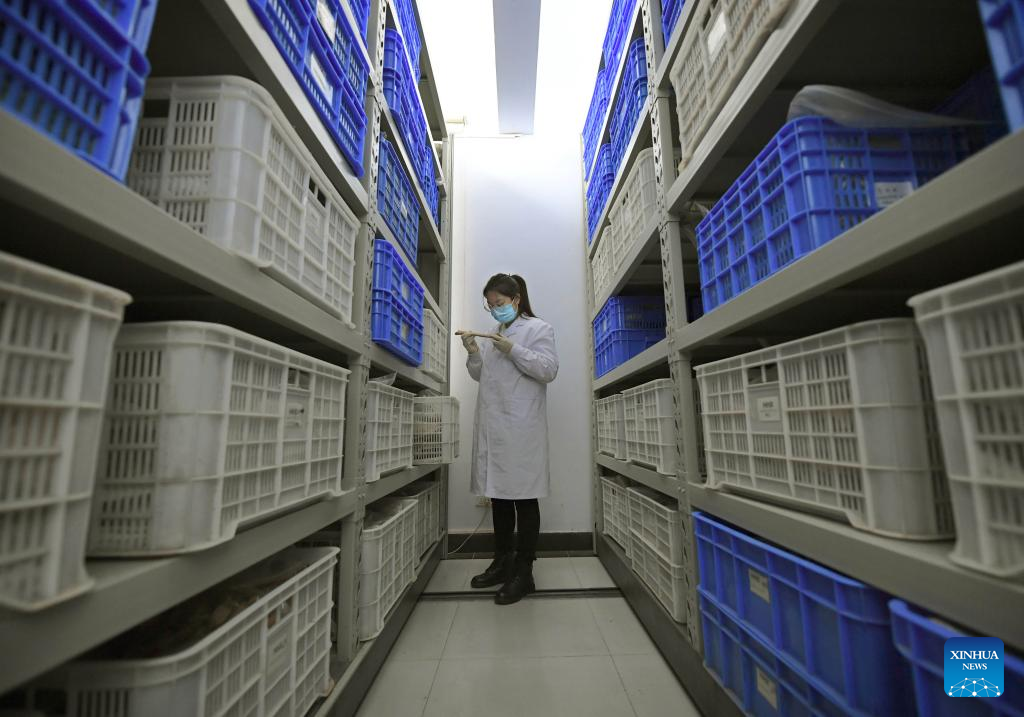
Li Yanzhen observes a human bone at Henan Institute of Cultural Relics and Archaeology in Zhengzhou, central China's Henan Province, Nov. 30, 2022.
At an office full of measuring tools and skeleton specimens at Henan Institute of Cultural Relics and Archaeology, Li Yanzhen, a "post-90s" girl, carefully measures and analyzes an ancient human bone, and speculates on the bone owner's height and nutritional status.
Li, who majored in archaeology, now studies physical anthropology. Li can extract hidden historical information from ancient human remains, such as physical characteristics, growth patterns, diet structure, the living environment, and ancient human customs, through a series of tasks such as cleaning, packaging, measurement, statistics, and analysis.
Li has come into contact with bones from over 30 relic sites from various periods during her four years of research, which lets bones that had been buried for hundreds of years "speak," unveiling the development and change of human society. (Xinhua/Li An)
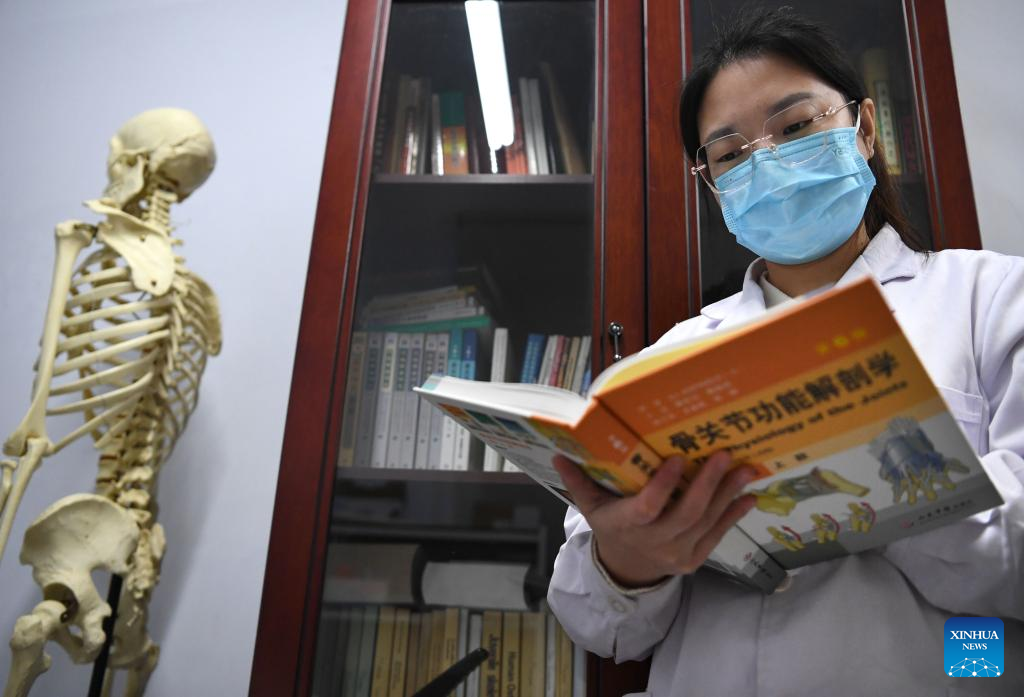
Li Yanzhen reads at Henan Institute of Cultural Relics and Archaeology in Zhengzhou, central China's Henan Province, Nov. 30, 2022.
At an office full of measuring tools and skeleton specimens at Henan Institute of Cultural Relics and Archaeology, Li Yanzhen, a "post-90s" girl, carefully measures and analyzes an ancient human bone, and speculates on the bone owner's height and nutritional status.
Li, who majored in archaeology, now studies physical anthropology. Li can extract hidden historical information from ancient human remains, such as physical characteristics, growth patterns, diet structure, the living environment, and ancient human customs, through a series of tasks such as cleaning, packaging, measurement, statistics, and analysis.
Li has come into contact with bones from over 30 relic sites from various periods during her four years of research, which lets bones that had been buried for hundreds of years "speak," unveiling the development and change of human society. (Xinhua/Li An)
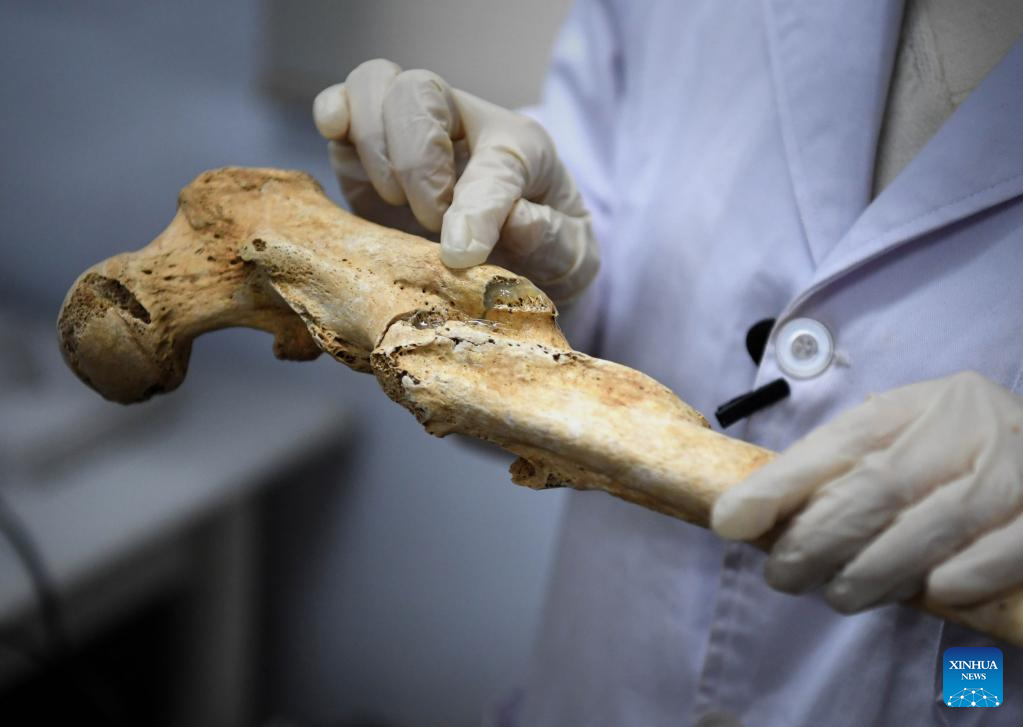
Li Yanzhen observes a human bone at Henan Institute of Cultural Relics and Archaeology in Zhengzhou, central China's Henan Province, Nov. 30, 2022.
At an office full of measuring tools and skeleton specimens at Henan Institute of Cultural Relics and Archaeology, Li Yanzhen, a "post-90s" girl, carefully measures and analyzes an ancient human bone, and speculates on the bone owner's height and nutritional status.
Li, who majored in archaeology, now studies physical anthropology. Li can extract hidden historical information from ancient human remains, such as physical characteristics, growth patterns, diet structure, the living environment, and ancient human customs, through a series of tasks such as cleaning, packaging, measurement, statistics, and analysis.
Li has come into contact with bones from over 30 relic sites from various periods during her four years of research, which lets bones that had been buried for hundreds of years "speak," unveiling the development and change of human society. (Xinhua/Li An)
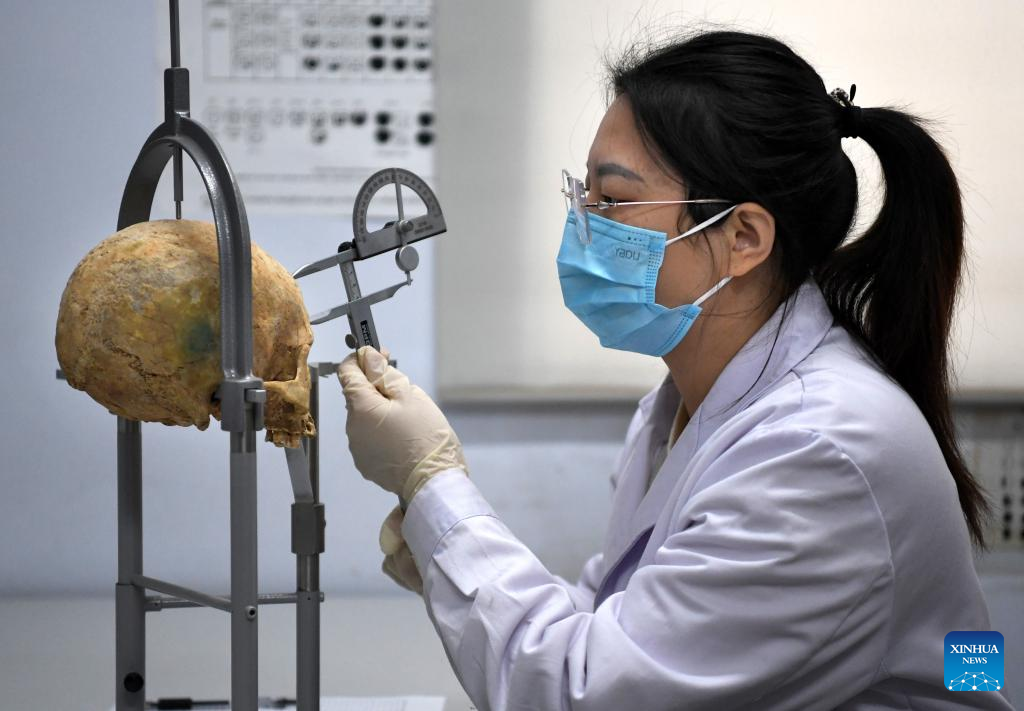
Li Yanzhen meaures a human skull at Henan Institute of Cultural Relics and Archaeology in Zhengzhou, central China's Henan Province, Nov. 30, 2022.
At an office full of measuring tools and skeleton specimens at Henan Institute of Cultural Relics and Archaeology, Li Yanzhen, a "post-90s" girl, carefully measures and analyzes an ancient human bone, and speculates on the bone owner's height and nutritional status.
Li, who majored in archaeology, now studies physical anthropology. Li can extract hidden historical information from ancient human remains, such as physical characteristics, growth patterns, diet structure, the living environment, and ancient human customs, through a series of tasks such as cleaning, packaging, measurement, statistics, and analysis.
Li has come into contact with bones from over 30 relic sites from various periods during her four years of research, which lets bones that had been buried for hundreds of years "speak," unveiling the development and change of human society. (Xinhua/Li An)
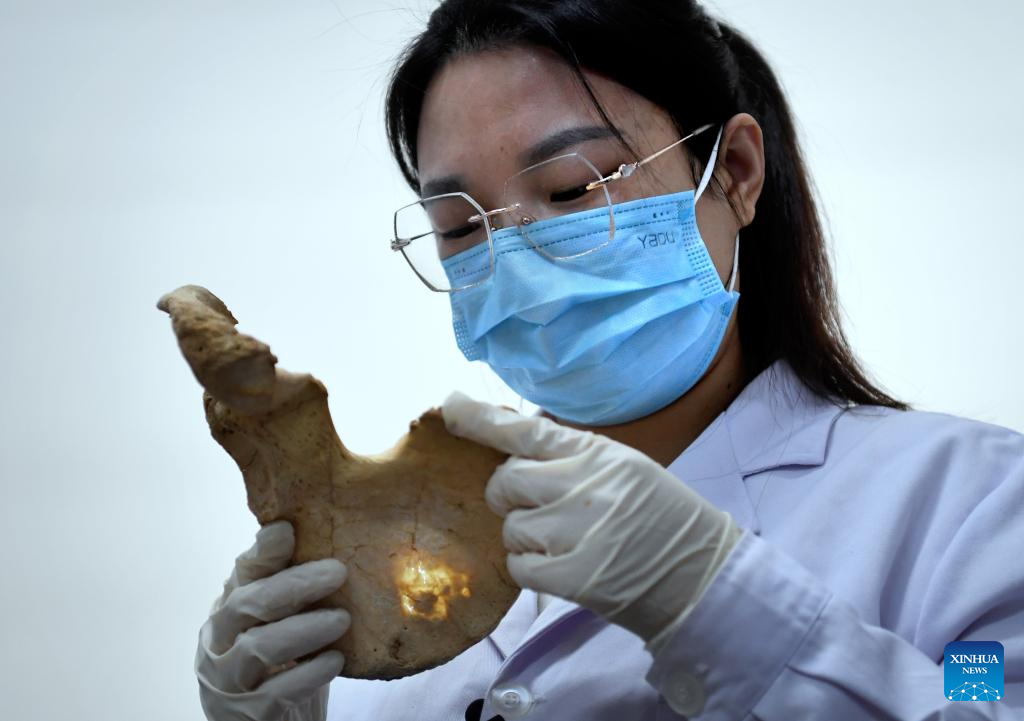
Li Yanzhen observes a human bone at Henan Institute of Cultural Relics and Archaeology in Zhengzhou, central China's Henan Province, Nov. 30, 2022.
At an office full of measuring tools and skeleton specimens at Henan Institute of Cultural Relics and Archaeology, Li Yanzhen, a "post-90s" girl, carefully measures and analyzes an ancient human bone, and speculates on the bone owner's height and nutritional status.
Li, who majored in archaeology, now studies physical anthropology. Li can extract hidden historical information from ancient human remains, such as physical characteristics, growth patterns, diet structure, the living environment, and ancient human customs, through a series of tasks such as cleaning, packaging, measurement, statistics, and analysis.
Li has come into contact with bones from over 30 relic sites from various periods during her four years of research, which lets bones that had been buried for hundreds of years "speak," unveiling the development and change of human society. (Xinhua/Li An)
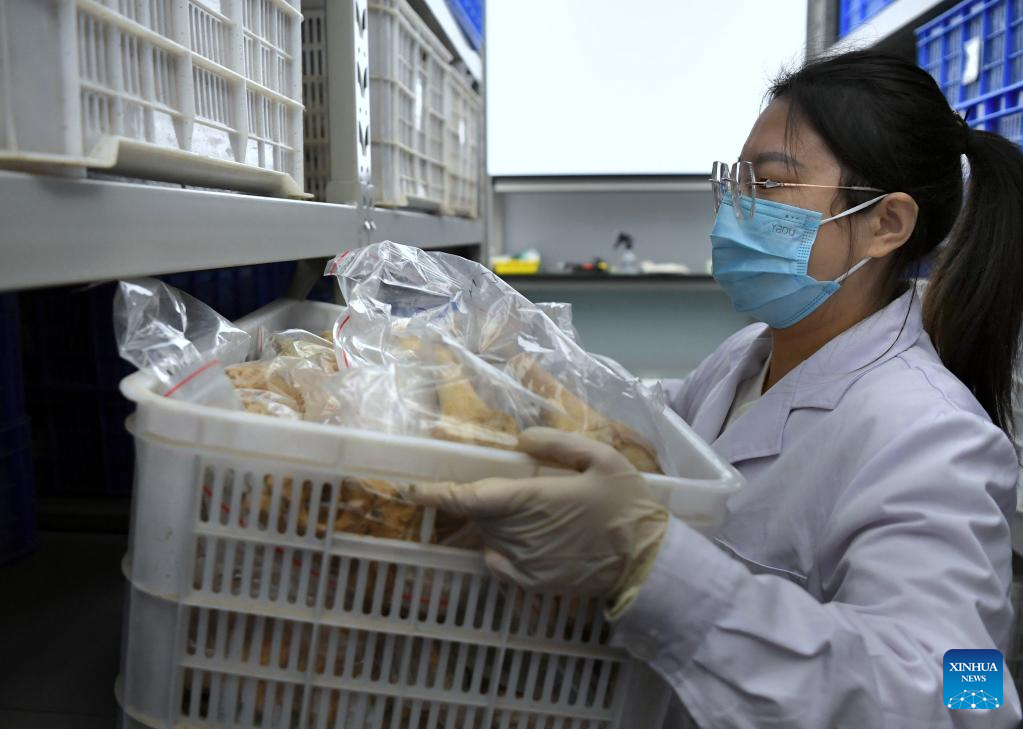
Li Yanzhen carries human bone specimens at Henan Institute of Cultural Relics and Archaeology in Zhengzhou, central China's Henan Province, Nov. 30, 2022.
At an office full of measuring tools and skeleton specimens at Henan Institute of Cultural Relics and Archaeology, Li Yanzhen, a "post-90s" girl, carefully measures and analyzes an ancient human bone, and speculates on the bone owner's height and nutritional status.
Li, who majored in archaeology, now studies physical anthropology. Li can extract hidden historical information from ancient human remains, such as physical characteristics, growth patterns, diet structure, the living environment, and ancient human customs, through a series of tasks such as cleaning, packaging, measurement, statistics, and analysis.
Li has come into contact with bones from over 30 relic sites from various periods during her four years of research, which lets bones that had been buried for hundreds of years "speak," unveiling the development and change of human society. (Xinhua/Li An)
